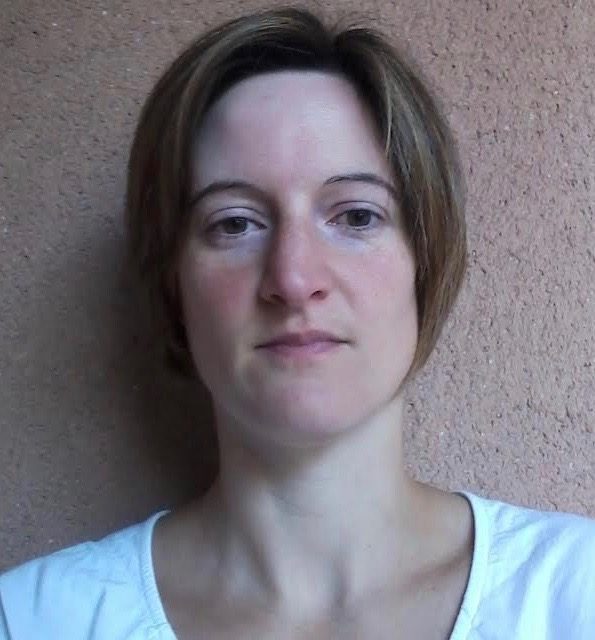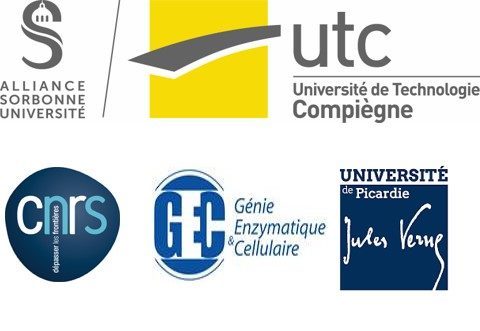Research Member of the theme “Plant Metabolism and Bioresources”. Understanding of lipid synthesis, regulation and accumulation mechanisms in oleaginous field crop cells and in reviviscent plants able to withstand extreme weather conditions. Plant metabolism, lipidomics and non-target metabolomics, isotopic profiling, fluxomics (MFA, INST-MFA, FBA). In charge of the Bioanalysis platform, UMR CNRS 7025. Development of analytical methods in mass spectrometry for fluxomics, metabolomics and non-targeted lipidomics. Member of the French network of metabolomics and fluxomics (http://www.rfmf.fr/). Member of the network of lipidomysts (http://lipidomystes.gerli.com/reseau/). General information Personal interests Badminton, music (Le dualo), gardening and organic farming, traveling. Articles Acket S., Degournay A., Rossez Y., Mottelet S., Villon P., Troncoso-ponce A., Thomasset B. 13C-Metabolic Flux Analysis in Developing Flax (Linum usitatissinum L.) Embryos to Understand Storage Lipid Biosynthesis
.
Metabolites
, 2020, 10,14. Martins-noguerol R., Moreno-perez A. J., Acket S., Troncoso-ponce A., Garces R., Thomasset B., Salas J. J. Et Martinez Force E. Impact of sunflower (Helianthus annuusL.) plastidial lipoyl synthases genes expression in glycerolipids of transgenic Arabidopsis plants
.
Scientific Reports
, 2020, 10
,3749-3764
. Martins-noguerol R., Moreno-pérez Aj., Acket S., Makni S., Garcés R., Troncoso-ponce A., Salas Jj., Thomasset B., Martínez-force E. Lipidomic Analysis of Plastidial Octanoyltransferase Mutants of Arabidopsis thaliana
.
Metabolites
, 2019, 9(10)
,209
. Bernard C., Acket S., Rossez Y ., Fernandez O., Berton T., Gibon Y., Cabasson C. Untargeted analysis of semipolar compounds by LC-MS and targeted analysis of fatty acids by GC-MS/GC-FID: From plant cultivation to extract preparation.
Methods Molec. Biol., 2018, 42,20171-20179. Acket S., Degournay A., Gosset M., Merlier F., Troncoso-ponce M. A. & Thomasset B. Analysis of C-13 labeling amino acids by capillary electrophoresis - High resolution mass spectrometry in developing flaxseed..
Anal. Biochem., 2018, 547,14-18. Tshabuse F., Farrant J. M., Humbert L., Moura D., Rainteau D., Espinasse C., Idrissi A., Merlier F., Acket S., Rafudeen M. S., Thomasset B. & Ruelland E. Glycerolipid analysis during desication and recovery of the resurrection plant Xerophyta humilis (Bak) Dur and Schinz..
Plant Cell Environ., 2018, 41,533-547. Acket S., Degournay A., Merlier F. & Thomasset B. Data documenting the comparison between the theoretically expected values of free sugars mass isotopomer composition with standards using GC-MS and LC-HRMS for Metabolic Flux Analysis..
Data in Brief, 2017, 12,108-112. Acket S., Degournay A., Merlier F. & Thomasset B. 13C labeling analysis of sugars by hight resolution-mass spectrometry for metabolic flux analysis..
Anal. Biochem., 2017, 527,45-48. Skills Secretary GEC, 3rd cycle, Master 2 Chemistry; assistance to the financial management of GEC unit Financial management assistance of GEC unit: Secretary of GEC unit and M2: General information Research Skills Lipidomics, small molecules, primary and secondary metabolites (amino acids, sugars, acyl-Coa, polyphenols, essential oils, …) Manager of the mass spectrometry platform of the Enzymatic and Cell Engineering Laboratory. Franck MERLIER studied analytical chemistry at the University of Rennes 1, Jules Vernes University of Amiens and Marie Curie High School in Nogent/Oise. He holds a master’s degree in chemistry, specializing in “Spectroscopic methods of analysis”. He is in charge of the mass spectrometry platform of the Enzymatic and Cell Engineering Laboratory at Compiègne University of Technology. Articles Xu J., Merlier F., Avalle B., Veillard V., Debré P., Haupt K., Tse Sum Bui B. Molecularly Imprinted Polymer Nanoparticles as Potential Synthetic Antibodies for Immunoprotection against HIV .
ACS Appl. Mater. Interfaces, 2019, 11,9824-9831. Ksouda G., Sellimi S., Merlier F., Facimaigne-cordin A., Thomasset B., Nasri M., Hajji M. Composition, antibacterial and antioxidant activities of Pimpinella saxifraga essential oil and application to cheese preservation as coating additive .
Food Chemistry, 2019, 288,47-56. Franche A., Imbs C., Fayeulle A., Merlier F., Billamboz M. Léonard E. Zinc-mediated reactions on salicylaldehyde for Botrytis cinerea control
.
Chinese Chemical Letters
, 2019, In press
,. Paruli E Iii., Griesser T., Merlier F., Gonzaro C., Haupt K. Molecularly imprinted polymers by thiol–yne chemistry: making imprinting even easier.
Polymer Chem.
, 2019, 10,4732-4739. Medina Rangel P., Moroni E., Merlier F., Gheber L., Vago R., Tse Sum Bui B., Haupt K. Chemical Antibody Mimics Inhibit Cadherin-Mediated Cell-Cell Adhesion: A Promising Strategy for Cancer Therapy.
Angewandte Chemie, 2019, In press
,. Merlier F., Octave S., Tse Sum Bui B., Thomasset B. Evaluation of Performance and Validity Limits of Gas Chromatography electron ionization – Orbitrap Detector for fatty acid methyl esters analyses
.
Rapid Commun Mass Spectrom, 2019, in press,. Ksouda G., Hajji M. Sellimi S., Merlier F., Falcimaigne Cordin A., Nasri M., Thomasset B. A Systematic Comparison of 25 Tunisian Plant Species Based on Oil and Phenolic Contents, Fatty Acid Composition and Antioxidant Activity.
Ind. Crops Prod, 2018, 274,432-440. Merlier F., Imatoukene N., Octave S., Nicaud J. M., Thomasset B. A Gas Chromatography Full Scan High Resolution Orbitrap Mass Spectrometry Method for Separation and Characterization of 3-Hydroxymethyl Pyridine Ester of Fatty Acids at Low Levels.
J. Chromatogr, 2018, 123,768-778. Acket S., Degournay A., Gosset M., Merlier F., Troncoso-ponce M. A. & Thomasset B. Analysis of C-13 labeling amino acids by capillary electrophoresis - High resolution mass spectrometry in developing flaxseed..
Anal. Biochem., 2018, 547,14-18. Tshabuse F., Farrant J. M., Humbert L., Moura D., Rainteau D., Espinasse C., Idrissi A., Merlier F., Acket S., Rafudeen M. S., Thomasset B. & Ruelland E. Glycerolipid analysis during desication and recovery of the resurrection plant Xerophyta humilis (Bak) Dur and Schinz..
Plant Cell Environ., 2018, 41,533-547. Mourao C. A., Bokeloh F., Xu J., Prost E., Duma L., Merlier F., Bueno S. M. A., Haupt K. & Tse Sum Bui, B. Dual oriented solid phase molecular imprinting: Toward selective artificial receptors for recognition of nucleotides in water.
Macromolecules, 2017, 50,7484-7490. Merlier F., Jellali R., Leclerc E. Online monitoring of hepatic rat metabolism by coupling a liver biochip and a mass spectrometer.
Analyst, 2017, 142,3747-3757. Acket S., Degournay A., Merlier F. & Thomasset B. Data documenting the comparison between the theoretically expected values of free sugars mass isotopomer composition with standards using GC-MS and LC-HRMS for Metabolic Flux Analysis..
Data in Brief, 2017, 12,108-112. Aimee Rasolohery C., Ermenegilde Ralaiba B., Ayerdi Gotor A., Merlier F., Benja R., Rakotovao M., Rhazi L. Chemical Characterization and Antioxidant Potential of Athroisma protei- formis Essential Oil.
The Natural Products Journal, 2017, 7,208-215. Acket S., Degournay A., Merlier F. & Thomasset B. 13C labeling analysis of sugars by hight resolution-mass spectrometry for metabolic flux analysis..
Anal. Biochem., 2017, 527,45-48. Nestora S., Merlier F., Prost E., Haupt K., Rossi C. & Tse Sum Bui B. Solid-phase extraction of betanin and isobetanin from beetroot extracts using a dipicolinic acid molecularly imprinted polymer..
J. Chromatogr. A, 2016, 1465,47-54. Nestora S., Merlier F., Beyazit S., Prost E., Duma L., Baril B., Graves A., Haupt K. & Tse Sum Bui B. Plastic antibodies for cosmetics: Molecularly imprinted polymers scavenge precursors of malodors. .
Angew. Chem. Int. Ed., 2016, 55,6252-6256. Jellali R., Bricks T., Jacques S., Fleury M. J., Paullier P., Merlier F. & Leclerc E. Long term human primary hepatocyte cultures in a microfluidic liver biochip show maintenance of mRNA levels and higher drugs metabolisms when compared to Petri cultures..
Biopharm. Drug Disp., 2016, 37,264-275. Bricks T., Hamon J., Fleury M. J., Jellali R., Merlier F., Herpe Y. E., Seyer A., Regimbeau J. M., Bois F. & Leclerc E. Investigation of omeprazole and phenacetin frist-pass metabolism in humans using a microscale bioreactor and pharmacokinetic models..
Biopharm. Drug Disp., 2015, 36,275-293. Nowacki L., Vigneron P., Rotellini L., Cazzola H., Merlier F., Prost E., Ralanairina R., Gadonna J. P., Rossi C. & Vayssade M. Betanin-enriched red beetroot (Beta vulgaris L.) extract induces apoptosis and autophagic cell death in MCF-7 cells..
Phytother. Res., 2015, 29,1964-1973. Prot J. M., Maciel L., Bricks T., Merlier F., Cotton J., Paullier P., Bois F. & Leclerc E. First pass intestinal and liver metabolism of paracetamol in a microfluidic platform coupled with a mathematical modeling as a means of evaluating ADME processes in humans..
Biotechnol. Bioeng., 2014, 111,2027-2040. Bricks T., Paullier P., Legendre A., Fleury M. J., Zeller P., Merlier F., Anton P. M. & Leclerc E. Development of a new microfluidic platform integrating co-cultures of intestinal and liver cell lines..
Toxicol. In Vitro, 2014, 28,885-895. Tanvir S., Merlier F. & Pulvin S. Biosensing of reactive intermediates produced by the photocatalytic activities of titanium dioxide nanoparticles..
J. Photochem. Photobiol. B, 2012, 110,22-27. Rippa S., Zhao Y., Merlier F., Charrier A. & Perrin Y. The carnitine biosynthetic pathway in Arabidopsis thaliana shares similar features with the pathway of mamals and fungi..
Plant Physiol. Biochem., 2012, 60,109-114. Patent E. Leclerc, P. Paullier, F. Merlier. Facility for coupling a bioreactor with a device for physicochemically analysing or collecting samples.
, 2014, ,. Skills Roles and responsabilities Secretary of part of GEC laboratory located in Amiens, Jules Verne University Personal interests Music, cinema Research I’m working at the interface between the theme “Plant Metabolism and Bioresources” and “Biomimicry and Biomolecular Recognition”. My research focuses on the exploration and exploitation of molecular diversity to modulate plant metabolism. The goal is to provide tools to optimize plant productivity either by acting directly on the metabolic pathways of interest, or by helping plants to adapt themselves to biotic and abiotic stresses. Skills Roles and responsabilities General information PhD in biology from the University of Poitiers (in 2005). Work focused on the study of the eutypiosis of the vine along two axes: understand the dialogue between the plant and the pathogenic fungus on the one hand and on the other hand develop tools to fight against infection. This latter approach was based on the use of natural molecules (amino acids and derivatives) and the use of pathogenic effectors to develop an immunoassay detection tool. Joined UTC as research engineer in 2006 in the Research Direction to assist researchers in their projects, from preparing call’s answer to the exploitation of results. Also involved in University’s programs, in particular in structuration and implementation of the ITE PIVERT. Member of the laboratory since July 2017. Main publications Articles Merlier F., Octave S., Tse Sum Bui B., Thomasset B. Evaluation of Performance and Validity Limits of Gas Chromatography electron ionization – Orbitrap Detector for fatty acid methyl esters analyses
.
Rapid Commun Mass Spectrom, 2019, in press,. Merlier F., Imatoukene N., Octave S., Nicaud J. M., Thomasset B. A Gas Chromatography Full Scan High Resolution Orbitrap Mass Spectrometry Method for Separation and Characterization of 3-Hydroxymethyl Pyridine Ester of Fatty Acids at Low Levels.
J. Chromatogr, 2018, 123,768-778. Roblin G., Octave S., Faucher M., Fleurat-lessard P. & Berjeaud J. M. Cysteine: A multifaceted amino acid involved in signaling, plant resistance and antifungal development..
Plant Physiol. Biochem., 2018, 129,77-89. Octave S., Fleurat-lessard P., Roblin G. Diagnosis of Eutypa lata infection by immunological detection in grapevine dying arm disease.
Journal of plant Pathology, 2009, 91,321-300. Octave S., Fleurat-lessard P., Roblin G. Effects of non-glycosylated and glycosylated polypeptides secreted by the grapevine pathogen Eutypa lata on the structural features and membrane processes in grapevine cells
.
Journal of plant Pathology
, 2008, 90,221-224. Octave S., Roblin G., Vachaud M., Fleurat-lessard P. Polypeptide metabolites secreted by the fungal pathogen Eutypa lata participate in Vitis vinifera L. to cell structure damage observed in Eutypa dieback
.
Functional Plant Biology
, 2006, 33
,297-307
. Octave S., Amborabe B. E., Fleurat-lessard P., Berges T., Roblin G. Modifications of plant cell activities by peptidic metabolites excreted by Eutypa lata, a vineyard fungal pathogen
.
Physiologia Plantarum
, 2006, 128
,103-115
. Rudelle J., Octave S., Kaid-arche M., Roblin G., Fleurat-lessard P. Structural modifications induced by Eutypa lata in the xylem of trunk and canes of Vitis vinifera
.
Functional Plant Biology
, 2005, 32
,537-547
. Research Member of the theme “Biomimicry and Biomolecular Diversity”. I’m CNRS engineer in the Enzymatic and Cell Engineering (GEC) laboratory and collaborate directly with Luminita Duma (CR CNRS) within the MIP team. I’m involved in the various projects of the unit that require NMR, Raman or InfraRed skills. Roles and responsabilities General information I’m chemist specialized in NMR thanks to my degree in physicochemical analysis and an internship on the NMR of oligosaccharides. My experiences in different laboratories have confirmed this expertise. I am since 2013, assigned to the GEC unit, as a CNRS engineer in charge of NMR, Raman and InfraRed devices. Main Publications Articles Xu J., Prost E., Haupt K. & Tse Sum Bui B. Direct and sensitive determination of trypsin in human urine using a water-soluble signaling fluorescent molecularly imprinted polymer nanoprobe. .
Sensor. Actuat. B-Chem. , 2018, 258,10-17. Mourao C. A., Bokeloh F., Xu J., Prost E., Duma L., Merlier F., Bueno S. M. A., Haupt K. & Tse Sum Bui, B. Dual oriented solid phase molecular imprinting: Toward selective artificial receptors for recognition of nucleotides in water.
Macromolecules, 2017, 50,7484-7490. Nestora S., Merlier F., Prost E., Haupt K., Rossi C. & Tse Sum Bui B. Solid-phase extraction of betanin and isobetanin from beetroot extracts using a dipicolinic acid molecularly imprinted polymer..
J. Chromatogr. A, 2016, 1465,47-54. Panagiotopoulou M., Salinas Y., Beyazit S., Kunath S., Mayes A. G., Duma L., Prost E., Resmini M., Tse Sum Bui B. & Haupt K. Molecularly imprinted polymer-coated quantum dots for multiplexed cell targeting and imaging..
Angew. Chem. Int. Ed., 2016, 55,8244-8248. Nestora S., Merlier F., Beyazit S., Prost E., Duma L., Baril B., Graves A., Haupt K. & Tse Sum Bui B. Plastic antibodies for cosmetics: Molecularly imprinted polymers scavenge precursors of malodors. .
Angew. Chem. Int. Ed., 2016, 55,6252-6256. Research I am involved in the “Plant Metabolism and Bioresources” theme to study the carnitine biosynthesis pathway in Arabidopsis and get insights in the carnitine physiological roles in plants, especially in lipid metabolism and stress tolerance. I collaborate with the “Biomimicry and Biomolecular Diversity” theme in a transversal approach to study interactions of natural amphiphilic compounds with biomimetic membranes and understand the mode of action of such molecules to trigger plant defenses or to inhibit phytopathogens. I study the physiological effects of the compounds, the defense pathways and mechanisms induced in plants (Arabidopsis, rapeseed) and microorganisms. I lead a more applicative project aiming to optimize and validate the efficiency of rhamnolipids to protect rapeseed from pathogenic fungi in the field. I look for new biocontrol agents or new biocontrol strategies. Skills Scientific skills: Plant physiology, plant defense, plant stress tolerance, phytopathogens, antimicrobial control, biocontrol Technical skills: Molecular biology, transcriptomic, biochemistry, plant mutants, microbiology, microscopy, mass spectrometry Roles and responsabilities General information My first academic research experience took place in 1998 in the Plant Science Institute (CNRS, Gif-sur-Yvette). I got molecular biology skills in the Dr A. Kondorosi’s laboratory, with Dr P. Ratet in a Medicago truncatula T-DNA tagging project. I then joined the group of Dr J. Giraudat to work with Dr F. Parcy to study the fine-tuning gene expression process during late embryogenesis in Arabidopsis. In 2001, I got an Engineer position in the University of Technology of Compiègne in the Enzyme and Cell Engineering Unit. In 2003, I started a PhD to study the interaction and the defense mechanisms induced by peptaibols (amphiphilic peptides mainly produced by Trichoderma fungi) on the plant Arabidopsis. In 2007, I got involved in a project aiming to study the carnitine role in plants. This project was initiated by Pr Y. Perrin in the PMB theme. I more precisely studied the carnitine biosynthesis pathway in Arabidopsis to identify enzymes involved in carnitine synthesis and to study mutants of these enzymes. Since 2014, as a Research Engineer, I have initiated a project with Pr C. Sarazin, to study the mode of perception/action of natural amphiphilic glycolipids by plants or against phytopathogens. Personal interests Reading, travelling, French gastronomy… Main publications Articles Monnier N., Furlan A-l., Buchoux S., Deleu M., Dauchez M., Rippa S., Sarazin C. Exploring the Dual Interaction of Natural Rhamnolipids with Plant and Fungal Biomimetic Plasma Membranes through Biophysical Studies" has been published in IJMS as part of the Special Issue SAR "Out of the Box.
Int. J. Mol. Sci., 2019, 20,1009. Furlan A., Laurin Y., Botcazon C., Rodríguez-moraga N., Rippa S., Deleu M., Lins L., Sarazin C., Buchoux s. Semi-purified rhamnolipid mixes protect Brassica napus against Leptosphaeria maculans early infections
.
Phytopathology
, 2019, 110(4)
,834-842
. Monnier M., Furlan A., Botcazon C., Dahi A., Mongelard G., Cordelier S., Clement C., Dorey S., Sarazin C., Rippa S. Rhamnolipids from Pseudomonas aeruginosa are elicitors triggering Brassica napus protection against Botrytis cinerea without physiological disorders.
Frontiers in Plant Science, 2018, 1778,101-124. Jacques F., Rippa S., Perrin Y. Physiology of L-carnitine in plants in light of the knowledge in animals and microorganisms.
Plant Science, 2018, 9,1170. Nguyen P. J., Rippa S., Rossez Y. & Perriny. Acylcarnitines participate in developmental processes associated to lipid metabolism in plants..
Planta, 2016, 243,1011-1022. Rippa S., Zhao Y., Merlier F., Charrier A. & Perrin Y. The carnitine biosynthetic pathway in Arabidopsis thaliana shares similar features with the pathway of mamals and fungi..
Plant Physiol. Biochem., 2012, 60,109-114. Charrier A., Rippa S., Yu A., Nguyen P. J., Renou J. P. & Perrin Y. The effect of carnitine on Arabidopsis development and recovery in salt stress conditions..
Planta, 2012, 235,123-135. Rippa S., Eid M., Formaggio F., Toniolo C & Beven L. Hypersensitive-like response to the pore-former peptaibol alamethicin in Arabidopsis thaliana.
Chembiochem, 2010, 11,2042-2049. Research Involved in research projects of the theme “Plant Metabolism and Bioresources”, namely with Sonia Rippa on “Inhibiting effect of compounds of mycelial growth of phytopathogenic fungi” and Yolande Perrin on “Biotechnology of microalgae”. Skills Plant cultures, DNA extraction, microbiological and biological assays. Financial management and collective logistics. SIFAC / CNRS Research Involved in research projects of the theme “Plant Metabolism and Bioresources” and, in particular, the transverse project “study of the interaction of bacterial flagella and biotic and abiotic surfaces” with Yannick Rossez. Plant cultures, extraction of molecules, biological and microbiological assays. Financial management and collective logistics. SIFAC / CNRS Technician in Biology. Order forms registration in SIFAC software as well as monitoring and distribution of biological and chemical product ordered. Unit consumables management (bunker, alcohols, laboratory consumables, office supplies). Registration of product entries and exits in the laboratory’s products database (GPUC). Tracking orders and relaunching suppliers in case of delay or undelivery. Personal interests Skills Roles and responsabilities General information Since 2014: Administrative manager of the Enzymatic and Cell Engineering unit, UMR 7025 CNRS Since 2012: CNRS/UTC safety assistant of the UMR7025 and, in particular, in charge of the prevention of risks (biological, chemical, etc.) and the training of students and new entrants in terms of risks and safety procedures. Main publications Articles Hodrogue A., Trecherel E., Cornu M., Darwiche W., Mansour A., Ait-mohand K., Verissimo T., Gomila C., Schembri C., Da Nascimento S., Elboutachfait R., Boulier A., Lorne E., Courtois J., Petit E., Toumieux S., Kovensky J., Sonnet P., Massy Z. A., Kamel S. Rossi C., Ausseil J. Oligogalacturonic acid inhibits vascular calcification by two mechanisms: inhibition of VSMC osteogenic conversion and interaction with collagen.
Arteriosclerosis, Thrombosis, and Vascular Biology, 2017, 37,1391-1401. Research Member of the theme “Biomimicry and Biomolecular Diversity”. Development of Molecular Imprinted Polymers (MIPs) and composite materials based on MIP for bioanalysis (separation, solid-phase extraction), biosensors, cellular bioimaging, controlled release of drugs, immunoassays (fluorescence, radioactivity, colorimetry) and enzyme inhibitors, odor and air pollutants suppresors. The developed MIPs target endocrine disruptors, antibiotics, mycotoxins, hormones, drugs, pesticides, nucleotides, amino acids, biogenic amines, cancer biomarkers (glycans, proteins, …) and they can be applied in domains such as nanomedicine, environment, agri-food, doping, cosmetology, biotechnology, … General information Degrees Profesionnal experience Supervision 3 post-docs, 13 PhDs, 3 masters Main publications Articles Mier A., Nestora S., Medina Rangel P., Rossez Y., Haupt K., Tse Sum Bui B. Cytocompatibility of Moleculary Imprinted Polymers for Deodorants : Evaluation on Human Keratinocytes and Axillary-Hosted Bacteria
.
ACS Appl. Mater. Interfaces
, 2019, 2
,3439-3447
Medina Rangel P., Caclef S., Xu J., Panagiotopoulou M., Kovensky J., Tse Sum Bui B., Haupt K. Solid-phase synthesis of moleculary imprinted polymer nanolabels: Affinity tools for cellular bioimaging of glycans.
Scientific Reports, 2019, 9,3923. Xu J., Merlier F., Avalle B., Veillard V., Debré P., Haupt K., Tse Sum Bui B. Molecularly Imprinted Polymer Nanoparticles as Potential Synthetic Antibodies for Immunoprotection against HIV .
ACS Appl. Mater. Interfaces, 2019, 11,9824-9831. Medina Rangel P., Moroni E., Merlier F., Gheber L., Vago R., Tse Sum Bui B., Haupt K. Chemical Antibody Mimics Inhibit Cadherin-Mediated Cell-Cell Adhesion: A Promising Strategy for Cancer Therapy.
Angewandte Chemie, 2019, In press
,. Merlier F., Octave S., Tse Sum Bui B., Thomasset B. Evaluation of Performance and Validity Limits of Gas Chromatography electron ionization – Orbitrap Detector for fatty acid methyl esters analyses
.
Rapid Commun Mass Spectrom, 2019, in press,. Xu J., Prost E., Haupt K. & Tse Sum Bui B. Direct and sensitive determination of trypsin in human urine using a water-soluble signaling fluorescent molecularly imprinted polymer nanoprobe. .
Sensor. Actuat. B-Chem. , 2018, 258,10-17. Mattsson L., Xu J., Preininger C., Tse Sum Bui B. & Haupt K. Competitive fluorescent pseudo-immunoassay exploiting molecularly imprinted polymers for the detection of biogenic amines in fish matrix..
Talanta, 2018, 181,190-196. Demir B., Lemberger M. M., Panagiotopoulou M., Medina Rangel P. X., Timur S., Hirsch T., Tse Sum Bui B., Wegener J. & Haupt K. Tracking hyaluronan: molecularly imprinted polymer coated carbon dots for cancer cell targeting and imaging..
ACS Appl. Mater. Interfaces, 2018, 10,3305-3313. Xu J, Haupt K. & Tse Sum Bui B. Core-shell molecularly imprinted polymer nanoparticles as synthetic antibodies in a sandwich fluoroimmunoassay for trypsin determination in human serum..
ACS Appl. Mater. Interfaces, 2017, 9, 24476?24483. Mourao C. A., Bokeloh F., Xu J., Prost E., Duma L., Merlier F., Bueno S. M. A., Haupt K. & Tse Sum Bui, B. Dual oriented solid phase molecular imprinting: Toward selective artificial receptors for recognition of nucleotides in water.
Macromolecules, 2017, 50,7484-7490. Panagiotopoulou M., Kunath S., Medina-rangel P. X., Haupt K. & Tse Sum Bui B. Fluorescent molecularly imprinted polymers as plastic antibodies for selective labeling and imaging of hyaluronan and sialic acid on fixed and living cells..
Biosens. Bioelectron., 2017, 88,85-93. Nestora S., Merlier F., Prost E., Haupt K., Rossi C. & Tse Sum Bui B. Solid-phase extraction of betanin and isobetanin from beetroot extracts using a dipicolinic acid molecularly imprinted polymer..
J. Chromatogr. A, 2016, 1465,47-54. Chia Gomez L. P., Spangenberg A., Ton X. A., Fuchs Y., Bokeloh F., Malval J. P., Tse Sum Bui B., Thuau D., Ayela C., Haupt K. & Soppera O. Rapid prototyping of chemical microsensors based on molecularly imprinted polymers synthesized by two-photon stereolithography..
Adv. Mater., 2016, 28,5931-5937. Parlak O., Beyazit S., Jafari M. J., Tse Sum Bui B., Haupt K., Tiwari A. & Turner A. P. F. Light-triggered switchable graphene-polymer hybrid bioelectronics..
Adv. Mater. Interfaces, 2016, 3,1500353. Panagiotopoulou M., Salinas Y., Beyazit S., Kunath S., Mayes A. G., Duma L., Prost E., Resmini M., Tse Sum Bui B. & Haupt K. Molecularly imprinted polymer-coated quantum dots for multiplexed cell targeting and imaging..
Angew. Chem. Int. Ed., 2016, 55,8244-8248. Nestora S., Merlier F., Beyazit S., Prost E., Duma L., Baril B., Graves A., Haupt K. & Tse Sum Bui B. Plastic antibodies for cosmetics: Molecularly imprinted polymers scavenge precursors of malodors. .
Angew. Chem. Int. Ed., 2016, 55,6252-6256. Xu J. J., Ambrosini S., Tamahkar E., Rossi C., Haupt K. & Tse Sum Bui B. Toward a universal method for preparing molecularly imprinted polymer nanoparticles with antibody-like affinity for proteins..
Biomacromolecules, 2016, 17,345-353. Parlak O., Beyazit S., Tse Sum Bui B., Haupt K., Turner A. P. F. & Tiwari A. Programmable bioelectronics in a stimuli-encoded 3D graphene interface..
Nanoscale, 2016, 8,9976-9981. Beyazit S., Tse Sum Bui B., Haupt K. & Gonzato C. Molecularly imprinted polymer nanomaterials and nanocomposites by controlled/living radical polymerization..
Prog. Polym. Sci., 2016, 62,1-21. Adali-kaya Z., Tse Sum Bui B., Falcimaigne-cordin A. & Haupt K. Molecularly imprinted polymer nanomaterials and nanocomposites: atom-transfer radical polymerization with acidic monomers..
Angew. Chem. Int. Ed., 2015, 54,192-195. Ton X. A., Acha V., Bonomi P., Tse Sum Bui B. & Haupt K. A disposable evanescent wave fiber optic sensor coated with a molecularly imprinted polymer as a selective fluorescent probe..
Biosens. Bioelectron., 2015, 64,359-366. Panagiotopoulou M., Beyazit S., Nestora S., Haupt K., & Tse Sum Bui B. Initiator-free synthesis of molecularly imprinted polymers by polymerization of self-initiated monomers..
Polymer, 2015, 66,43-51. Foguel M. V., Ton X. A., Zanoni M. V. B., Sotomayor M. D. P. T., Haupt K. & Tse Sum Bui B. A molecularly imprinted polymer-based evanescent wave fiber optic sensor for the detection of basic red 9 dye. .
Sens. Actuators B, 2015, 218,222-228. Beyazit S., Ambrosini S., Marchyk N., Palo E., Kale V., Soukka T., Tse Sum Bui B. & Haupt K. Versatile synthetic strategy for coating upconverting nanoparticles with polymer shells through localized photopolymerization by using the particles as internal light sources..
Angew. Chem. Int. Ed., 2014, 53,8919-8923. Li B., Xu J., Hall A. J., Haupt K. & Tse Sum Bui B. Water-compatible silica sol-gel molecularly imprinted polymer as potential delivery system for the controlled release of salicylic acid..
J. Mol. Recognit., 2014, 27,559-565. Marchyk N., Maximilien J., Beyazit S., Haupt K. & Tse Sum Bui B. One-pot synthesis of iniferter-bound polystyrene core nanoparticles for the controlled grafting of multilayer shells..
Nanoscale, 2014, 6,2872-2878. Cakir P., Cutivet A., Resmini M., Tse Sum Bui B. & Haupt K. Protein-size molecularly imprinted polymer nanogels as synthetic antibodies, by localized polymerization with multi-initiators..
Adv. Mater., 2013, 25,1048-1051. Ton X. A., Tse Sum Bui B., Resmini M., Bonomi P., Dika I., Soppera O. & Haupt K. A versatile fiber-optic fluorescence sensor based on molecularly imprinted microstructures polymerized in situ..
Angew. Chem. Int. Ed., 2013, 52,8317-8321. Ambrosini S., Beyazit S., Haupt K. & Tse Sum Bui B. Solid-phase synthesis of molecularly imprinted nanoparticles for protein recognition..
Chem. Commun., 2013, 49,6746-6748. Ton X. A., Acha V., Haupt K. & Tse Sum Bui B. Direct fluorimetric sensing of UV-excited analytes in biological and environmental samples using molecularly imprinted polymer nanoparticles and fluorescence polarization..
Biosens. Bioelectron., 2012, 36,22-28. Haupt K., Linares A. V., Bompart M. & Tse Sum Bui B. Molecularly imprinted polymers..
Top. Curr. Chem., 2012, 325,1-28. Harz S., Shimmelpfennig M., Tse Sum Bui B., Marchyk N., Haupt K. & Feller K. H. Fluorescence optical spectrally resolved sensor based on molecularly imprinted polymers and microfluidics..
Eng. Life Sci., 2011, 11,559-565. Tse Sum Bui B. & Haupt K. Preparation and evaluation of a molecularly imprinted polymer for the selective recognition of testosterone application to molecularly imprinted sorbent assays..
J. Mol. Recognit., 2011, 24,1123-1129. Piperno S., Tse Sum Bui B., Haupt K. & Ghebert L. A. Immobilization of molecularly imprinted polymer nanoparticles in electrospun poly(vinyl alcohol) nanofibers..
Langmuir, 2011, 27,1547-1550. Tse Sum Bui B. & Haupt K. Molecularly imprinted polymers : synthetic receptors in bioanalysis.
Anal. Bioanal. Chem., 2010, 398,2481-2492. Tse Sum Bui B., Merlier F. & Haupt K. Towards the use of a molecularly imprinted polymer in doping analysis :selective preconcentration and analysis of testosterone and epitestosterone in human urine..
Anal. Chem., 2010, 82,4420-4427. Lotierzo M., Tse Sum Bui B., Leech H. K., Warren M. J., Marquet A. & Rigby S. E. J. Iron-sulfur cluster dynamics in biotin synthase: A new [2Fe-2S]1+ cluster..
Biochem. Biophys. Res. Commun. , 2009, 381,487-490. BOOK Xu J, Medina-rangel P. X., Haupt K. & Tse Sum Bui B. Guide to the preparation of molecularly imprinted polymer nanoparticles for protein recognition, by solid-phase synthesis.
Methods Enzymol, 2017, ,pp.115-141 Panagiotopoulou M., Kunath S., Haupt K., Tse Sum Bui B. Cell and Tissue Imaging with Molecularly Imprinted Polymers .
Methods in Molecular Biology, 2017, ,PP.399-415 Maximilien J., Beyazit S., Rossi C., Haupt K. & Tse Sum Bui B Nanoparticles in biomedical applications.
Measuring Biological impacts of nanomaterials, 2016, Springer International Publishing, Switzerland,pp. 177-210













Sébastien ACKET
Skills
Roles and responsabilities
![]()
![]()
![]()
![]()
![]() ABSTRACT: The way plants are grown and samples are harvested, prepared, and extracted has a profound impact on the output of a metabolomics experiment. In this chapter, we detail the experimental procedures from plant cultivation to extract preparation, in order to avoid difficulties that could result in contamination or undesired changes of the analytes. Two plant organs are mentioned as examples: tomato fruits (Solanum lycopersicum) and flax seeds (Linum usitatissimum). Extractions designed for the untargeted analysis of semipolar compounds by liquid chromatography
ABSTRACT: The way plants are grown and samples are harvested, prepared, and extracted has a profound impact on the output of a metabolomics experiment. In this chapter, we detail the experimental procedures from plant cultivation to extract preparation, in order to avoid difficulties that could result in contamination or undesired changes of the analytes. Two plant organs are mentioned as examples: tomato fruits (Solanum lycopersicum) and flax seeds (Linum usitatissimum). Extractions designed for the untargeted analysis of semipolar compounds by liquid chromatography
![]()
![]() ABSTRACT: n context of fluxomic studies, 13C labeling analysis of amino acids are very important for solving the carbon flow calculation, because they are synthesized in various biosynthesis pathways and cellular compartments in plant cells. Traditionally, 13C labeling analysis are performed using low resolution mass spectrometry detector by GC-MS. We compared a method using capillary electrophoresis-high resolution mass spectrometry without derivatization and with better accuracy assessment of labeling measurements comparing to classical GC-MS. Our method allowed us to show that valine, leucine, alanine are not synthesized from the same pyruvate pool during the period of reserves accumulation in flax seeds.
ABSTRACT: n context of fluxomic studies, 13C labeling analysis of amino acids are very important for solving the carbon flow calculation, because they are synthesized in various biosynthesis pathways and cellular compartments in plant cells. Traditionally, 13C labeling analysis are performed using low resolution mass spectrometry detector by GC-MS. We compared a method using capillary electrophoresis-high resolution mass spectrometry without derivatization and with better accuracy assessment of labeling measurements comparing to classical GC-MS. Our method allowed us to show that valine, leucine, alanine are not synthesized from the same pyruvate pool during the period of reserves accumulation in flax seeds.
![]()
![]() ABSTRACT: Feelings in humans are mental states representing groups of physiological functions that usually have defined behavioural purposes. Feelings, being evolutionarily ancient, are thought to be coordinated in the brain stem of animals. One function of the brain is to prioritise between competing mental states and, thus, groups of physiological functions and in turn behaviour. Plants use groups of coordinated physiological activities to deal with defined environmental situations but currently have no known mental state to prioritise any order of response. Plants do have a nervous system based on action potentials transmitted along phloem conduits but which in addition, through anastomoses and other cross?links, forms a complex network. The emergent potential for this excitable network to form a mental state is unknown, but it might be used to distinguish between different and even contradictory signals to the individual plant and thus determine a priority of response. This plant nervous system stretches throughout the whole plant providing the potential for assessment in all parts and commensurate with its self?organising, phenotypically plastic behaviour. Plasticity may, in turn, depend heavily on the instructive capabilities of local bioelectric fields enabling both a degree of behavioural independence but influenced by the condition of the whole plant.
ABSTRACT: Feelings in humans are mental states representing groups of physiological functions that usually have defined behavioural purposes. Feelings, being evolutionarily ancient, are thought to be coordinated in the brain stem of animals. One function of the brain is to prioritise between competing mental states and, thus, groups of physiological functions and in turn behaviour. Plants use groups of coordinated physiological activities to deal with defined environmental situations but currently have no known mental state to prioritise any order of response. Plants do have a nervous system based on action potentials transmitted along phloem conduits but which in addition, through anastomoses and other cross?links, forms a complex network. The emergent potential for this excitable network to form a mental state is unknown, but it might be used to distinguish between different and even contradictory signals to the individual plant and thus determine a priority of response. This plant nervous system stretches throughout the whole plant providing the potential for assessment in all parts and commensurate with its self?organising, phenotypically plastic behaviour. Plasticity may, in turn, depend heavily on the instructive capabilities of local bioelectric fields enabling both a degree of behavioural independence but influenced by the condition of the whole plant.
![]()
![]() ABSTRACT: The data presented in this article are related to the research article entitled
ABSTRACT: The data presented in this article are related to the research article entitled
![]()
![]() ABSTRACT: Metabolic flux analysis is particularly complex in plant cells because of highly compartmented metabolism. Analysis of free sugars is interesting because it provides data to define fluxes around hexose, pentose, and triose phosphate pools in different compartment. In this work, we present a method to analyze the isotopomer distribution of free sugars labeled with carbon 13 using a liquid chromatography
ABSTRACT: Metabolic flux analysis is particularly complex in plant cells because of highly compartmented metabolism. Analysis of free sugars is interesting because it provides data to define fluxes around hexose, pentose, and triose phosphate pools in different compartment. In this work, we present a method to analyze the isotopomer distribution of free sugars labeled with carbon 13 using a liquid chromatography
Virginie LAMBERTYN
Morgane LUPPI
Administrative and financial management
Roles and responsabilities
Franck MERLIER
Roles and responsabilities
General information
![]()
![]() ABSTRACT: We describe the preparation and characterization of synthetic antibodies based on molecularly imprinted polymer nanoparticles (MIP-NPs) for the recognition and binding of the highly conserved and specific peptide motif SWSNKS (3S), an epitope of the envelope glycoprotein 41 (gp41) of human immunodeficiency virus type 1 (HIV-1). This motif is implicated in the decline of CD4+ T cells and leads to the deterioration of the immune system during HIV infection. Therefore, the development of MIP-NPs that can target and block the 3S peptide to prevent subsequent cascade interactions directed toward the killing of CD4+ T cells is of prime importance. Because most antibodies recognize their protein antigen via a conformational or structured epitope (as opposed to a linear epitope commonly used for molecular imprinting), we employed protein molecular modeling to design our template epitope so that it mimics the three-dimensional structure fold of 3S in gp41. The resulting template peptide corresponds to a cyclic structure composed of CGSWSNKSC, with the 3S motif well orientated for imprinting. MIP-NPs with a size of 65 nm were obtained by solid-phase synthesis and were water-soluble. They were prepared by a judicious combination of multiple functional monomers affording hydrogen bonding, ionic, π–π, and hydrophobic interactions, conferring high affinity and selectivity toward both the cyclic peptide and the whole gp41 protein. These results suggest that our MIPs could potentially be used for blocking the function of the 3S motif on the virus.
ABSTRACT: We describe the preparation and characterization of synthetic antibodies based on molecularly imprinted polymer nanoparticles (MIP-NPs) for the recognition and binding of the highly conserved and specific peptide motif SWSNKS (3S), an epitope of the envelope glycoprotein 41 (gp41) of human immunodeficiency virus type 1 (HIV-1). This motif is implicated in the decline of CD4+ T cells and leads to the deterioration of the immune system during HIV infection. Therefore, the development of MIP-NPs that can target and block the 3S peptide to prevent subsequent cascade interactions directed toward the killing of CD4+ T cells is of prime importance. Because most antibodies recognize their protein antigen via a conformational or structured epitope (as opposed to a linear epitope commonly used for molecular imprinting), we employed protein molecular modeling to design our template epitope so that it mimics the three-dimensional structure fold of 3S in gp41. The resulting template peptide corresponds to a cyclic structure composed of CGSWSNKSC, with the 3S motif well orientated for imprinting. MIP-NPs with a size of 65 nm were obtained by solid-phase synthesis and were water-soluble. They were prepared by a judicious combination of multiple functional monomers affording hydrogen bonding, ionic, π–π, and hydrophobic interactions, conferring high affinity and selectivity toward both the cyclic peptide and the whole gp41 protein. These results suggest that our MIPs could potentially be used for blocking the function of the 3S motif on the virus.
![]()
![]() ABSTRACT: The effect of Pimpinella saxifraga essential oil (PSEO) addition (1-3%) in sodium alginate coating on the bacterial and oxidative stability of cheese was studied during refrigerated storage. The GC–HRMS analysis of PSEO showed that anethole, pseudoisoeugenol and p-anisaldehyde were the main components. The PSEO exhibited strong in vitro DPPH radical scavenging activity (IC50 = 6.81 µg/mL), β-carotene bleaching inhibition (IC50 = 206 µg/mL), ferric reducing power (EC50 = 35.20 µg/mL), total antioxidant activity (213.96 ± 11.12 µmol/mL α-tocopherol equivalent) and notable DNA protection potential. Additionally, PSEO displayed potent antibacterial activity against 3 Gram-positive and 3 Gram-negative bacteria (MICs = 0.78-3.12 mg/mL). The acute toxicity of PSEO was determined using mice model (LD50 = 976.2 mg/kg). The enrichment of sodium alginate coating with PSEO, particularly at 3%, improved cheese preservation by reducing the weight loss, preserving the pH and color and enhancing oxidative and bacterial stability without unpleased flavor for consumers.
ABSTRACT: The effect of Pimpinella saxifraga essential oil (PSEO) addition (1-3%) in sodium alginate coating on the bacterial and oxidative stability of cheese was studied during refrigerated storage. The GC–HRMS analysis of PSEO showed that anethole, pseudoisoeugenol and p-anisaldehyde were the main components. The PSEO exhibited strong in vitro DPPH radical scavenging activity (IC50 = 6.81 µg/mL), β-carotene bleaching inhibition (IC50 = 206 µg/mL), ferric reducing power (EC50 = 35.20 µg/mL), total antioxidant activity (213.96 ± 11.12 µmol/mL α-tocopherol equivalent) and notable DNA protection potential. Additionally, PSEO displayed potent antibacterial activity against 3 Gram-positive and 3 Gram-negative bacteria (MICs = 0.78-3.12 mg/mL). The acute toxicity of PSEO was determined using mice model (LD50 = 976.2 mg/kg). The enrichment of sodium alginate coating with PSEO, particularly at 3%, improved cheese preservation by reducing the weight loss, preserving the pH and color and enhancing oxidative and bacterial stability without unpleased flavor for consumers.
![]()
![]()
![]()
![]()
![]()
![]() ABSTRACT: This study investigated 25 Tunisian plant species of 13 families based on their oil and total phenolic contents. The fatty acid profiles and antioxidant activity of phenolic extracts of these plant seeds were studied in order to identify species containing unusual fatty acids and potential antioxidants. The oil content varied from 4.2 to 66.5% of DW (Dry Weight). Fatty acid profiles were determined using gas chromatography analysis coupled to flame ionization detection and high resolution mass spectrometry (GC-FID and GC-HRMS). The results showed that plant seeds were mostly composed of classic fatty acids (palmitic, oleic, linoleic and linolenic acids), while unusual fatty acids such as long-chain and odd-chain fatty acids were minor components. However, the petroselinic acid was the major component of Apiaceae family seed oil, particularly in Pimpinella saxifraga and Pimpinella major. The phenolic content of seed methanolic extracts, measured by Folin
ABSTRACT: This study investigated 25 Tunisian plant species of 13 families based on their oil and total phenolic contents. The fatty acid profiles and antioxidant activity of phenolic extracts of these plant seeds were studied in order to identify species containing unusual fatty acids and potential antioxidants. The oil content varied from 4.2 to 66.5% of DW (Dry Weight). Fatty acid profiles were determined using gas chromatography analysis coupled to flame ionization detection and high resolution mass spectrometry (GC-FID and GC-HRMS). The results showed that plant seeds were mostly composed of classic fatty acids (palmitic, oleic, linoleic and linolenic acids), while unusual fatty acids such as long-chain and odd-chain fatty acids were minor components. However, the petroselinic acid was the major component of Apiaceae family seed oil, particularly in Pimpinella saxifraga and Pimpinella major. The phenolic content of seed methanolic extracts, measured by Folin
![]()
![]() ABSTRACT: Fatty acid methyl esters (FAMEs), which are commonly used to characterize lipids, have several limitations to conclude on many structures. 3-Pyridylcarbinol esters (3-PCE) are used to characterize fatty acid structures [1], in particular, to identify ring and double bond positions on the carbon chain. Chromatographic separation of these esters is complex due to their polarity and high boiling points. In this study, we used a column with high resolutive power based on ionic liquids to increase the separation quality in gas chromatography (GC). In addition, we used a high-resolution detector (Orbitrap) to limit non-specific signals and improve the detection limits. This detector could be used with a mass filter at 5?ppm for the rapid determination of 3-PCE from its characteristic ions (m/z?=?108.0441 and 92.0495). This filter allowed the identification of derivative fatty acids with good sensibility. Thus, it was possible to characterize 3-PCE by measuring the exact fragment masses to confirm structures such as C19:2n12cyclo?9.
ABSTRACT: Fatty acid methyl esters (FAMEs), which are commonly used to characterize lipids, have several limitations to conclude on many structures. 3-Pyridylcarbinol esters (3-PCE) are used to characterize fatty acid structures [1], in particular, to identify ring and double bond positions on the carbon chain. Chromatographic separation of these esters is complex due to their polarity and high boiling points. In this study, we used a column with high resolutive power based on ionic liquids to increase the separation quality in gas chromatography (GC). In addition, we used a high-resolution detector (Orbitrap) to limit non-specific signals and improve the detection limits. This detector could be used with a mass filter at 5?ppm for the rapid determination of 3-PCE from its characteristic ions (m/z?=?108.0441 and 92.0495). This filter allowed the identification of derivative fatty acids with good sensibility. Thus, it was possible to characterize 3-PCE by measuring the exact fragment masses to confirm structures such as C19:2n12cyclo?9.
![]()
![]() ABSTRACT: n context of fluxomic studies, 13C labeling analysis of amino acids are very important for solving the carbon flow calculation, because they are synthesized in various biosynthesis pathways and cellular compartments in plant cells. Traditionally, 13C labeling analysis are performed using low resolution mass spectrometry detector by GC-MS. We compared a method using capillary electrophoresis-high resolution mass spectrometry without derivatization and with better accuracy assessment of labeling measurements comparing to classical GC-MS. Our method allowed us to show that valine, leucine, alanine are not synthesized from the same pyruvate pool during the period of reserves accumulation in flax seeds.
ABSTRACT: n context of fluxomic studies, 13C labeling analysis of amino acids are very important for solving the carbon flow calculation, because they are synthesized in various biosynthesis pathways and cellular compartments in plant cells. Traditionally, 13C labeling analysis are performed using low resolution mass spectrometry detector by GC-MS. We compared a method using capillary electrophoresis-high resolution mass spectrometry without derivatization and with better accuracy assessment of labeling measurements comparing to classical GC-MS. Our method allowed us to show that valine, leucine, alanine are not synthesized from the same pyruvate pool during the period of reserves accumulation in flax seeds.
![]()
![]() ABSTRACT: Feelings in humans are mental states representing groups of physiological functions that usually have defined behavioural purposes. Feelings, being evolutionarily ancient, are thought to be coordinated in the brain stem of animals. One function of the brain is to prioritise between competing mental states and, thus, groups of physiological functions and in turn behaviour. Plants use groups of coordinated physiological activities to deal with defined environmental situations but currently have no known mental state to prioritise any order of response. Plants do have a nervous system based on action potentials transmitted along phloem conduits but which in addition, through anastomoses and other cross?links, forms a complex network. The emergent potential for this excitable network to form a mental state is unknown, but it might be used to distinguish between different and even contradictory signals to the individual plant and thus determine a priority of response. This plant nervous system stretches throughout the whole plant providing the potential for assessment in all parts and commensurate with its self?organising, phenotypically plastic behaviour. Plasticity may, in turn, depend heavily on the instructive capabilities of local bioelectric fields enabling both a degree of behavioural independence but influenced by the condition of the whole plant.
ABSTRACT: Feelings in humans are mental states representing groups of physiological functions that usually have defined behavioural purposes. Feelings, being evolutionarily ancient, are thought to be coordinated in the brain stem of animals. One function of the brain is to prioritise between competing mental states and, thus, groups of physiological functions and in turn behaviour. Plants use groups of coordinated physiological activities to deal with defined environmental situations but currently have no known mental state to prioritise any order of response. Plants do have a nervous system based on action potentials transmitted along phloem conduits but which in addition, through anastomoses and other cross?links, forms a complex network. The emergent potential for this excitable network to form a mental state is unknown, but it might be used to distinguish between different and even contradictory signals to the individual plant and thus determine a priority of response. This plant nervous system stretches throughout the whole plant providing the potential for assessment in all parts and commensurate with its self?organising, phenotypically plastic behaviour. Plasticity may, in turn, depend heavily on the instructive capabilities of local bioelectric fields enabling both a degree of behavioural independence but influenced by the condition of the whole plant.
![]()
![]() ABSTRACT: We describe the synthesis of water-soluble molecularly imprinted polymer nanoparticles (MIP-NPs) as a new artificial host receptor for the recognition of adenosine monophosphate (AMP), used herein, as a model nucleotide. MIP-NPs were prepared by solid-phase synthesis on glass beads (GB) using, for the first time, immobilized Fe(III)-chelate as an affinity ligand to orientate the AMP via its phosphate group. A polymerizable thymine monomer which can induce complementary base-pairing with the adenine moiety of the nucleotide was synthesized and incorporated in the polymerization mixture to constrain the AMP in a dual-orientated configuration. The MIP-NPs were remarkably selective toward AMP as they did not bind other nucleotides, GMP, UMP, and CMP. This strategy of using the phosphate group of AMP as a hinge enables unhindered pairing of the nucleobase with its corresponding complementary base monomer and can be extended to the preparation of specific MIP receptors for other key nucleotides in aqueous conditions.
ABSTRACT: We describe the synthesis of water-soluble molecularly imprinted polymer nanoparticles (MIP-NPs) as a new artificial host receptor for the recognition of adenosine monophosphate (AMP), used herein, as a model nucleotide. MIP-NPs were prepared by solid-phase synthesis on glass beads (GB) using, for the first time, immobilized Fe(III)-chelate as an affinity ligand to orientate the AMP via its phosphate group. A polymerizable thymine monomer which can induce complementary base-pairing with the adenine moiety of the nucleotide was synthesized and incorporated in the polymerization mixture to constrain the AMP in a dual-orientated configuration. The MIP-NPs were remarkably selective toward AMP as they did not bind other nucleotides, GMP, UMP, and CMP. This strategy of using the phosphate group of AMP as a hinge enables unhindered pairing of the nucleobase with its corresponding complementary base monomer and can be extended to the preparation of specific MIP receptors for other key nucleotides in aqueous conditions.
![]()
![]() ABSTRACT: A microfluidic liver biochip was coupled with a mass spectrometer to detect in real time the drug metabolism of hepatocytes. The hepatocytes were cultivated in the biochip for 35 h. The biochip was placed in a small-scale incubator in which the temperature and CO2 concentration were controlled. The biochip was connected serially to a mass spectrometer, a peristaltic pump and a culture medium reservoir. The injection in the mass spectrometer was performed every 10 min for 11 h. The metabolism of midazolam, phenacetin, omeprazole, dextromethorphan, repaglinide, rosuvastatin, tolbutamide and caffeine was investigated. We monitored the apparition of omeprazole sulfone, hydroxy omeprazole, repaglinide glucuronide, rosuvastatin lactone, dextrorphan, 1-hydroxy midazolam, 4-hydroxy midazolam, 1,4-hydroxy midazolam, paracetamol and 1,3-methylxanthine. Although these were observed, hydroxytolbutamide, 3-methoxymorphinan and midazolam glucuronide, hydroxy repaglinide were not detected. Based on a pharmacokinetic model, we calculated in vitro intrinsic clearances in which adsorption onto the perfusion circuit was taken into account. Then, using a liver organ model, we extrapolated the in vitro intrinsic clearances to the in vivo clearances. The estimated in vivo clearances were in agreement with the literature data on rats for midazolam, dextromethorphan, phenacetin, tolbutamide and caffeine. Rosuvastatin, omeprazole and repaglinide prediction underestimated the in vivo data.
ABSTRACT: A microfluidic liver biochip was coupled with a mass spectrometer to detect in real time the drug metabolism of hepatocytes. The hepatocytes were cultivated in the biochip for 35 h. The biochip was placed in a small-scale incubator in which the temperature and CO2 concentration were controlled. The biochip was connected serially to a mass spectrometer, a peristaltic pump and a culture medium reservoir. The injection in the mass spectrometer was performed every 10 min for 11 h. The metabolism of midazolam, phenacetin, omeprazole, dextromethorphan, repaglinide, rosuvastatin, tolbutamide and caffeine was investigated. We monitored the apparition of omeprazole sulfone, hydroxy omeprazole, repaglinide glucuronide, rosuvastatin lactone, dextrorphan, 1-hydroxy midazolam, 4-hydroxy midazolam, 1,4-hydroxy midazolam, paracetamol and 1,3-methylxanthine. Although these were observed, hydroxytolbutamide, 3-methoxymorphinan and midazolam glucuronide, hydroxy repaglinide were not detected. Based on a pharmacokinetic model, we calculated in vitro intrinsic clearances in which adsorption onto the perfusion circuit was taken into account. Then, using a liver organ model, we extrapolated the in vitro intrinsic clearances to the in vivo clearances. The estimated in vivo clearances were in agreement with the literature data on rats for midazolam, dextromethorphan, phenacetin, tolbutamide and caffeine. Rosuvastatin, omeprazole and repaglinide prediction underestimated the in vivo data.
![]()
![]() ABSTRACT: The data presented in this article are related to the research article entitled
ABSTRACT: The data presented in this article are related to the research article entitled
![]()
![]()
![]() ABSTRACT: Metabolic flux analysis is particularly complex in plant cells because of highly compartmented metabolism. Analysis of free sugars is interesting because it provides data to define fluxes around hexose, pentose, and triose phosphate pools in different compartment. In this work, we present a method to analyze the isotopomer distribution of free sugars labeled with carbon 13 using a liquid chromatography
ABSTRACT: Metabolic flux analysis is particularly complex in plant cells because of highly compartmented metabolism. Analysis of free sugars is interesting because it provides data to define fluxes around hexose, pentose, and triose phosphate pools in different compartment. In this work, we present a method to analyze the isotopomer distribution of free sugars labeled with carbon 13 using a liquid chromatography
![]()
![]()
![]()
![]()
![]()
![]()
![]()
![]()
![]()
![]()
![]() ABSTRACT: The invention concerns a facility for coupling a bioreactor for culturing bio-organisms, in dynamic mode, with at least one device for physicochemically analyzing a fluid from this bioreactor or collecting samples of this fluid, the device being equipped with a pump and an injector, the bioreactor being equipped with means for supplying culture medium and xenobiotic(s). The facility is remarkable in that the bioreactor is connected to a closed perfusion loop provided with a pump, fitted with a sampling loop and in that the facility comprises: a device for injecting a cleaning product into said sampling loop, two six-way valves, the first valve being connected to the closed perfusion loop, to the sampling loop and to a cleaning loop, the second valve being connected to the cleaning loop and an injection loop that connects the injector to at least one of the devices.
ABSTRACT: The invention concerns a facility for coupling a bioreactor for culturing bio-organisms, in dynamic mode, with at least one device for physicochemically analyzing a fluid from this bioreactor or collecting samples of this fluid, the device being equipped with a pump and an injector, the bioreactor being equipped with means for supplying culture medium and xenobiotic(s). The facility is remarkable in that the bioreactor is connected to a closed perfusion loop provided with a pump, fitted with a sampling loop and in that the facility comprises: a device for injecting a cleaning product into said sampling loop, two six-way valves, the first valve being connected to the closed perfusion loop, to the sampling loop and to a cleaning loop, the second valve being connected to the cleaning loop and an injection loop that connects the injector to at least one of the devices.
Laëtitia NUNCQ
Assistance with budget management: SIFAC consultation, contacts with financial and research services
General information
Stéphane OCTAVE
![]()
![]()
![]() ABSTRACT: Fatty acid methyl esters (FAMEs), which are commonly used to characterize lipids, have several limitations to conclude on many structures. 3-Pyridylcarbinol esters (3-PCE) are used to characterize fatty acid structures [1], in particular, to identify ring and double bond positions on the carbon chain. Chromatographic separation of these esters is complex due to their polarity and high boiling points. In this study, we used a column with high resolutive power based on ionic liquids to increase the separation quality in gas chromatography (GC). In addition, we used a high-resolution detector (Orbitrap) to limit non-specific signals and improve the detection limits. This detector could be used with a mass filter at 5?ppm for the rapid determination of 3-PCE from its characteristic ions (m/z?=?108.0441 and 92.0495). This filter allowed the identification of derivative fatty acids with good sensibility. Thus, it was possible to characterize 3-PCE by measuring the exact fragment masses to confirm structures such as C19:2n12cyclo?9.
ABSTRACT: Fatty acid methyl esters (FAMEs), which are commonly used to characterize lipids, have several limitations to conclude on many structures. 3-Pyridylcarbinol esters (3-PCE) are used to characterize fatty acid structures [1], in particular, to identify ring and double bond positions on the carbon chain. Chromatographic separation of these esters is complex due to their polarity and high boiling points. In this study, we used a column with high resolutive power based on ionic liquids to increase the separation quality in gas chromatography (GC). In addition, we used a high-resolution detector (Orbitrap) to limit non-specific signals and improve the detection limits. This detector could be used with a mass filter at 5?ppm for the rapid determination of 3-PCE from its characteristic ions (m/z?=?108.0441 and 92.0495). This filter allowed the identification of derivative fatty acids with good sensibility. Thus, it was possible to characterize 3-PCE by measuring the exact fragment masses to confirm structures such as C19:2n12cyclo?9.
![]()
![]() ABSTRACT: Early effects induced by cysteine were monitored using the model of Mimosa pudica pulvinar cells. Rapid dose-dependent membrane depolarization (within seconds) and modification of proton secretion (within minutes) were triggered at cysteine concentrations higher than 0.1?mM. These effects did not result from a modification of the plasma membrane H+-ATPase activity nor from a protonophore effect as shown by assays on plasma membrane vesicles isolated from pulvinar tissues. In a 0.5
ABSTRACT: Early effects induced by cysteine were monitored using the model of Mimosa pudica pulvinar cells. Rapid dose-dependent membrane depolarization (within seconds) and modification of proton secretion (within minutes) were triggered at cysteine concentrations higher than 0.1?mM. These effects did not result from a modification of the plasma membrane H+-ATPase activity nor from a protonophore effect as shown by assays on plasma membrane vesicles isolated from pulvinar tissues. In a 0.5
![]()
![]()
![]()
![]()
![]()
Elise PROST
![]()
![]() ABSTRACT: https://doi.org/10.1016/j.snb.2017.11.077
ABSTRACT: https://doi.org/10.1016/j.snb.2017.11.077
![]()
![]() ABSTRACT: We describe the synthesis of water-soluble molecularly imprinted polymer nanoparticles (MIP-NPs) as a new artificial host receptor for the recognition of adenosine monophosphate (AMP), used herein, as a model nucleotide. MIP-NPs were prepared by solid-phase synthesis on glass beads (GB) using, for the first time, immobilized Fe(III)-chelate as an affinity ligand to orientate the AMP via its phosphate group. A polymerizable thymine monomer which can induce complementary base-pairing with the adenine moiety of the nucleotide was synthesized and incorporated in the polymerization mixture to constrain the AMP in a dual-orientated configuration. The MIP-NPs were remarkably selective toward AMP as they did not bind other nucleotides, GMP, UMP, and CMP. This strategy of using the phosphate group of AMP as a hinge enables unhindered pairing of the nucleobase with its corresponding complementary base monomer and can be extended to the preparation of specific MIP receptors for other key nucleotides in aqueous conditions.
ABSTRACT: We describe the synthesis of water-soluble molecularly imprinted polymer nanoparticles (MIP-NPs) as a new artificial host receptor for the recognition of adenosine monophosphate (AMP), used herein, as a model nucleotide. MIP-NPs were prepared by solid-phase synthesis on glass beads (GB) using, for the first time, immobilized Fe(III)-chelate as an affinity ligand to orientate the AMP via its phosphate group. A polymerizable thymine monomer which can induce complementary base-pairing with the adenine moiety of the nucleotide was synthesized and incorporated in the polymerization mixture to constrain the AMP in a dual-orientated configuration. The MIP-NPs were remarkably selective toward AMP as they did not bind other nucleotides, GMP, UMP, and CMP. This strategy of using the phosphate group of AMP as a hinge enables unhindered pairing of the nucleobase with its corresponding complementary base monomer and can be extended to the preparation of specific MIP receptors for other key nucleotides in aqueous conditions.
![]()
![]()
![]()
Sonia RIPPA
![]()
![]()
![]()
![]() ABSTRACT: Rhamnolipids (RLs) are amphiphilic molecules naturally produced by some bacteria with a large range of biological activities. Although some studies report their potential interest in plant protection, evaluation of their effects and efficiency on annual crops of worldwide agronomic interest is lacking. The main objective of this work was to investigate their elicitor and protective activities on rapeseed crop species while evaluating their physiological effects. Here we report that RLs from Pseudomonas aeruginosa secretome trigger an effective protection of Brassica napus foliar tissues toward the fungus Botrytis cinerea involving the combination of plant defense activation and direct antimicrobial properties. We demonstrated their ability to activate canonical B. napus defense responses including reactive oxygen species production, expression of defense genes, along with callose deposits and stomatal closure as efficient physical protections. In addition, microscopic cell death observations and electrolyte leakage measurements indicated that RLs trigger a hypersensitive response-like defense in this plant. We also showed that foliar spray applications of RLs do not induce deleterious physiological consequences on plant growth or chlorophyll content and that RL protective properties are efficient on several grown cultivars of rapeseed. To our knowledge, this is the first report of RLs as an elicitor that suppresses fungal disease on tissues of an annual crop species under greenhouse conditions. Our results highlight the dual mode of action of these molecules exhibiting plant protection activation and antifungal activities and demonstrate their potential for crop cultures as environmental-friendly biocontrol solution.
ABSTRACT: Rhamnolipids (RLs) are amphiphilic molecules naturally produced by some bacteria with a large range of biological activities. Although some studies report their potential interest in plant protection, evaluation of their effects and efficiency on annual crops of worldwide agronomic interest is lacking. The main objective of this work was to investigate their elicitor and protective activities on rapeseed crop species while evaluating their physiological effects. Here we report that RLs from Pseudomonas aeruginosa secretome trigger an effective protection of Brassica napus foliar tissues toward the fungus Botrytis cinerea involving the combination of plant defense activation and direct antimicrobial properties. We demonstrated their ability to activate canonical B. napus defense responses including reactive oxygen species production, expression of defense genes, along with callose deposits and stomatal closure as efficient physical protections. In addition, microscopic cell death observations and electrolyte leakage measurements indicated that RLs trigger a hypersensitive response-like defense in this plant. We also showed that foliar spray applications of RLs do not induce deleterious physiological consequences on plant growth or chlorophyll content and that RL protective properties are efficient on several grown cultivars of rapeseed. To our knowledge, this is the first report of RLs as an elicitor that suppresses fungal disease on tissues of an annual crop species under greenhouse conditions. Our results highlight the dual mode of action of these molecules exhibiting plant protection activation and antifungal activities and demonstrate their potential for crop cultures as environmental-friendly biocontrol solution.
![]()
![]() ABSTRACT: L-carnitine is present in all living kingdoms where it acts in diverse physiological processes. It is involved in lipid metabolism in animals and yeasts, notably as an essential cofactor of fatty acid intracellular trafficking. Its physiological significance is poorly understood in plants, but L-carnitine may be linked to fatty acid metabolism among other roles. Indeed, carnitine transferases activities and acylcarnitines are measured in plant tissues. Current knowledge of fatty acid trafficking in plants rules out acylcarnitines as intermediates of the peroxisomal and mitochondrial fatty acid metabolism, unlike in animals and yeasts. Instead, acylcarnitines could be involved in plastidial exportation of de novo fatty acid, or importation of fatty acids into the ER, for synthesis of specific glycerolipids. L-carnitine also contributes to cellular maintenance though antioxidant and osmolyte properties in animals and microbes. Recent data indicate similar features in plants, together with modulation of signaling pathways. The biosynthesis of L-carnitine in the plant cell shares similar precursors as in the animal and yeast cells. The elucidation of the biosynthesis pathway of L-carnitine, and the identification of the enzymes involved, is today essential to progress further in the comprehension of its biological significance in plants.
ABSTRACT: L-carnitine is present in all living kingdoms where it acts in diverse physiological processes. It is involved in lipid metabolism in animals and yeasts, notably as an essential cofactor of fatty acid intracellular trafficking. Its physiological significance is poorly understood in plants, but L-carnitine may be linked to fatty acid metabolism among other roles. Indeed, carnitine transferases activities and acylcarnitines are measured in plant tissues. Current knowledge of fatty acid trafficking in plants rules out acylcarnitines as intermediates of the peroxisomal and mitochondrial fatty acid metabolism, unlike in animals and yeasts. Instead, acylcarnitines could be involved in plastidial exportation of de novo fatty acid, or importation of fatty acids into the ER, for synthesis of specific glycerolipids. L-carnitine also contributes to cellular maintenance though antioxidant and osmolyte properties in animals and microbes. Recent data indicate similar features in plants, together with modulation of signaling pathways. The biosynthesis of L-carnitine in the plant cell shares similar precursors as in the animal and yeast cells. The elucidation of the biosynthesis pathway of L-carnitine, and the identification of the enzymes involved, is today essential to progress further in the comprehension of its biological significance in plants.
![]()
![]()
![]()
![]()
Valérie SANTONI
Valérie ROBQUIN
Skills
Roles and responsabilities
General information
Cooking, decorationCarol SCHEMBRI
In charge of the administrative management of the UMR, which is under three trusteeship (CNRS / UTC / UPJV), namely: Finances Human resources Communication![]()
Bernadette TSE SUM BUI
![]() Contact Bernadette Tse Sum Bui
Contact Bernadette Tse Sum Bui
Bin Li: Molecularly imprinted polymers for applications in cosmetology (2013).
Xuan-Anh Ton: Fiber optic chemical sensors based on molecularly imprinted polymers for the detection of mycotoxins (2013).
Selim Beyazit: Functional nanoparticles for biomedical applications (2014).
Jacqueline Maximilien: Studies of the impact of core-shell polystyrene nanoparticles on cell membranes and biomimetic models (2015).
Maria Panagiotopoulou: Organic-inorganic composite materials for specific recognition and optical detection of environmental, food and biomedical analytes (2016).
Sofia Nestora: Molecularly imprinted polymers as selective sorbents for recognition in complex aqueous samples (2017).
Jingjing Xu: Solid-phase synthesis of molecularly imprinted polymer nanoparticles for protein recognition (2017).
Paulina Rangel: Molecularly imprinted nanostructures for cell differentiation.
Alejandra Mier: Molecularly imprinted polymer nanocomposites for cancer cell recognition and cell imaging.![]() ABSTRACT: https://doi.org/10.1021/acsabm.9b00388
ABSTRACT: https://doi.org/10.1021/acsabm.9b00388
![]()
![]()
![]() ABSTRACT: We describe the preparation and characterization of synthetic antibodies based on molecularly imprinted polymer nanoparticles (MIP-NPs) for the recognition and binding of the highly conserved and specific peptide motif SWSNKS (3S), an epitope of the envelope glycoprotein 41 (gp41) of human immunodeficiency virus type 1 (HIV-1). This motif is implicated in the decline of CD4+ T cells and leads to the deterioration of the immune system during HIV infection. Therefore, the development of MIP-NPs that can target and block the 3S peptide to prevent subsequent cascade interactions directed toward the killing of CD4+ T cells is of prime importance. Because most antibodies recognize their protein antigen via a conformational or structured epitope (as opposed to a linear epitope commonly used for molecular imprinting), we employed protein molecular modeling to design our template epitope so that it mimics the three-dimensional structure fold of 3S in gp41. The resulting template peptide corresponds to a cyclic structure composed of CGSWSNKSC, with the 3S motif well orientated for imprinting. MIP-NPs with a size of 65 nm were obtained by solid-phase synthesis and were water-soluble. They were prepared by a judicious combination of multiple functional monomers affording hydrogen bonding, ionic, π–π, and hydrophobic interactions, conferring high affinity and selectivity toward both the cyclic peptide and the whole gp41 protein. These results suggest that our MIPs could potentially be used for blocking the function of the 3S motif on the virus.
ABSTRACT: We describe the preparation and characterization of synthetic antibodies based on molecularly imprinted polymer nanoparticles (MIP-NPs) for the recognition and binding of the highly conserved and specific peptide motif SWSNKS (3S), an epitope of the envelope glycoprotein 41 (gp41) of human immunodeficiency virus type 1 (HIV-1). This motif is implicated in the decline of CD4+ T cells and leads to the deterioration of the immune system during HIV infection. Therefore, the development of MIP-NPs that can target and block the 3S peptide to prevent subsequent cascade interactions directed toward the killing of CD4+ T cells is of prime importance. Because most antibodies recognize their protein antigen via a conformational or structured epitope (as opposed to a linear epitope commonly used for molecular imprinting), we employed protein molecular modeling to design our template epitope so that it mimics the three-dimensional structure fold of 3S in gp41. The resulting template peptide corresponds to a cyclic structure composed of CGSWSNKSC, with the 3S motif well orientated for imprinting. MIP-NPs with a size of 65 nm were obtained by solid-phase synthesis and were water-soluble. They were prepared by a judicious combination of multiple functional monomers affording hydrogen bonding, ionic, π–π, and hydrophobic interactions, conferring high affinity and selectivity toward both the cyclic peptide and the whole gp41 protein. These results suggest that our MIPs could potentially be used for blocking the function of the 3S motif on the virus.
![]()
![]()
![]()
![]() ABSTRACT: https://doi.org/10.1016/j.snb.2017.11.077
ABSTRACT: https://doi.org/10.1016/j.snb.2017.11.077
![]()
![]() ABSTRACT: We developed a competitive fluorescent molecularly imprinted polymer (MIP) assay to detect biogenic amines in fish samples. MIPs synthesized by precipitation polymerization using histamine as template were used in a batch binding assay analogous to competitive fluoroimmunoassays. Introducing a complex sample matrix, such as fish extract, into the assay changes the environment and the binding conditions, therefore the importance of the sample preparation is extensively discussed. Several extraction and purification methods for fish were comprehensively studied, and an optimal clean-up procedure for fish samples using liquid-liquid extraction was developed. The feasibility of the competitive MIP assay was shown in the purified fish extract over a broad histamine range (1 ? 430ʵM). The MIP had the highest affinity towards histamine, but recognized also the structurally similar biogenic amines tyramine and tryptamine, as well as spermine and spermidine, providing simultaneous analysis and assessment of the total amount of biogenic amines.
ABSTRACT: We developed a competitive fluorescent molecularly imprinted polymer (MIP) assay to detect biogenic amines in fish samples. MIPs synthesized by precipitation polymerization using histamine as template were used in a batch binding assay analogous to competitive fluoroimmunoassays. Introducing a complex sample matrix, such as fish extract, into the assay changes the environment and the binding conditions, therefore the importance of the sample preparation is extensively discussed. Several extraction and purification methods for fish were comprehensively studied, and an optimal clean-up procedure for fish samples using liquid-liquid extraction was developed. The feasibility of the competitive MIP assay was shown in the purified fish extract over a broad histamine range (1 ? 430ʵM). The MIP had the highest affinity towards histamine, but recognized also the structurally similar biogenic amines tyramine and tryptamine, as well as spermine and spermidine, providing simultaneous analysis and assessment of the total amount of biogenic amines.
![]()
![]() ABSTRACT: War against cancer constantly requires new affinity tools to selectively detect, localize, and quantify biomarkers for diagnosis or prognosis. Herein, carbon nanodots (CDs), an emerging class of fluorescent nanomaterials, coupled with molecularly imprinted polymers (MIPs), are employed as a biocompatible optical imaging tool for probing cancer biomarkers. First, N-doped CDs were prepared by hydrothermal synthesis using starch as carbon source and l-tryptophan as nitrogen atom provider to achieve a high quantum yield of 25.1
ABSTRACT: War against cancer constantly requires new affinity tools to selectively detect, localize, and quantify biomarkers for diagnosis or prognosis. Herein, carbon nanodots (CDs), an emerging class of fluorescent nanomaterials, coupled with molecularly imprinted polymers (MIPs), are employed as a biocompatible optical imaging tool for probing cancer biomarkers. First, N-doped CDs were prepared by hydrothermal synthesis using starch as carbon source and l-tryptophan as nitrogen atom provider to achieve a high quantum yield of 25.1
![]()
![]() ABSTRACT: We describe the application of a fluorescently labeled water-soluble core
ABSTRACT: We describe the application of a fluorescently labeled water-soluble core
![]()
![]() ABSTRACT: We describe the synthesis of water-soluble molecularly imprinted polymer nanoparticles (MIP-NPs) as a new artificial host receptor for the recognition of adenosine monophosphate (AMP), used herein, as a model nucleotide. MIP-NPs were prepared by solid-phase synthesis on glass beads (GB) using, for the first time, immobilized Fe(III)-chelate as an affinity ligand to orientate the AMP via its phosphate group. A polymerizable thymine monomer which can induce complementary base-pairing with the adenine moiety of the nucleotide was synthesized and incorporated in the polymerization mixture to constrain the AMP in a dual-orientated configuration. The MIP-NPs were remarkably selective toward AMP as they did not bind other nucleotides, GMP, UMP, and CMP. This strategy of using the phosphate group of AMP as a hinge enables unhindered pairing of the nucleobase with its corresponding complementary base monomer and can be extended to the preparation of specific MIP receptors for other key nucleotides in aqueous conditions.
ABSTRACT: We describe the synthesis of water-soluble molecularly imprinted polymer nanoparticles (MIP-NPs) as a new artificial host receptor for the recognition of adenosine monophosphate (AMP), used herein, as a model nucleotide. MIP-NPs were prepared by solid-phase synthesis on glass beads (GB) using, for the first time, immobilized Fe(III)-chelate as an affinity ligand to orientate the AMP via its phosphate group. A polymerizable thymine monomer which can induce complementary base-pairing with the adenine moiety of the nucleotide was synthesized and incorporated in the polymerization mixture to constrain the AMP in a dual-orientated configuration. The MIP-NPs were remarkably selective toward AMP as they did not bind other nucleotides, GMP, UMP, and CMP. This strategy of using the phosphate group of AMP as a hinge enables unhindered pairing of the nucleobase with its corresponding complementary base monomer and can be extended to the preparation of specific MIP receptors for other key nucleotides in aqueous conditions.
![]()
![]() ABSTRACT: Altered glycosylation levels or distribution of sialic acids (SA) or hyaluronan in animal cells are indicators of pathological conditions like infection or malignancy. We applied fluorescently-labeled molecularly imprinted polymer (MIP) particles for bioimaging of fixed and living human keratinocytes, to localize hyaluronan and sialylation sites. MIPs were prepared with the templates D-glucuronic acid (GlcA), a substructure of hyaluronan, and N-acetylneuraminic acid (NANA), the most common member of SA. Both MIPs were found to be highly selective towards their target monosaccharides, as no cross-reactivity was observed with other sugars like N-acetyl-D-glucosamine, N-acetyl-D-galactosamine, D-glucose and D-galactose, present on the cell surface. The dye rhodamine and two InP/ZnS quantum dots (QDs) emitting in the green and in the red regions were used as fluorescent probes. Rhodamine-MIPGlcA and rhodamine-MIPNANA were synthesized as monodispersed 400 nm sized particles and were found to bind selectively their targets located in the extracellular region, as imaged by epifluorescence and confocal microscopy. In contrast, when MIP-GlcA and MIP-NANA particles with a smaller size (125 nm) were used, the MIPs being synthesized as thin shells around green and red emitting QDs respectively, it was possible to stain the intracellular and pericellular regions as well. In addition, simultaneous dual-color imaging with the two different colored QDs-MIPs was demonstrated. Importantly, the MIPs were not cytotoxic and did not affect cell viability; neither was the cells morphology affected as demonstrated by live cell imaging. These synthetic receptors could offer a new and promising imaging tool to monitor disease progression.
ABSTRACT: Altered glycosylation levels or distribution of sialic acids (SA) or hyaluronan in animal cells are indicators of pathological conditions like infection or malignancy. We applied fluorescently-labeled molecularly imprinted polymer (MIP) particles for bioimaging of fixed and living human keratinocytes, to localize hyaluronan and sialylation sites. MIPs were prepared with the templates D-glucuronic acid (GlcA), a substructure of hyaluronan, and N-acetylneuraminic acid (NANA), the most common member of SA. Both MIPs were found to be highly selective towards their target monosaccharides, as no cross-reactivity was observed with other sugars like N-acetyl-D-glucosamine, N-acetyl-D-galactosamine, D-glucose and D-galactose, present on the cell surface. The dye rhodamine and two InP/ZnS quantum dots (QDs) emitting in the green and in the red regions were used as fluorescent probes. Rhodamine-MIPGlcA and rhodamine-MIPNANA were synthesized as monodispersed 400 nm sized particles and were found to bind selectively their targets located in the extracellular region, as imaged by epifluorescence and confocal microscopy. In contrast, when MIP-GlcA and MIP-NANA particles with a smaller size (125 nm) were used, the MIPs being synthesized as thin shells around green and red emitting QDs respectively, it was possible to stain the intracellular and pericellular regions as well. In addition, simultaneous dual-color imaging with the two different colored QDs-MIPs was demonstrated. Importantly, the MIPs were not cytotoxic and did not affect cell viability; neither was the cells morphology affected as demonstrated by live cell imaging. These synthetic receptors could offer a new and promising imaging tool to monitor disease progression.
![]()
![]()
![]()
![]()
![]()
![]()
![]()
![]()
![]()
![]()
![]()
![]()
![]()
![]()
![]()
![]()
![]()
![]()
![]()
![]()
![]()
![]()
![]()
![]()
![]()
![]()
Sébastien ACKET
Manager Analytical Platform
Pascal BOULNOIS
Informatics Correspondent - Maintenance
Virginie LAMBERTYN
Manager Analytical Platform - Safety Assistant UPJV/CNRS
Morgane LUPPI
Secretary UTC - Finances
Franck MERLIER
Manager of Mass Spectrometry Platform
Laëtitia NUNCQ
Secretary UPJV - Finances
Stéphane OCTAVE
Innovation Correspondent - Member Steering Committee of "Science Festival" UTC
Elise PROST
Training Correspondent - Manager RMN/RAMAN/FTIR Platform
Sonia RIPPA
Co-animator theme PMB - Competent Person in Radiation Protection - Manager of L2 & S2
Valérie SANTONI
Logistics - Management Chemical Products Database
Valérie ROBQUIN
Logistics - Management Chemical Products Database
Carol SCHEMBRI
Administration, Finances, Communication - Safety Assistant UTC/CNRS
Bernadette TSE SUM BUI
Manager Analytical Platform
Manager Analytical Platform - Safety Assistant UPJV/CNRS
Secretary UTC - Finances
Manager of Mass Spectrometry Platform
Secretary UPJV - Finances
Innovation Correspondent - Member Steering Committee of "Science Festival" UTC
Training Correspondent - Manager RMN/RAMAN/FTIR Platform
Co-animator theme PMB - Competent Person in Radiation Protection - Manager of L2 & S2
Logistics - Management Chemical Products Database
Logistics - Management Chemical Products Database
Administration, Finances, Communication - Safety Assistant UTC/CNRS
